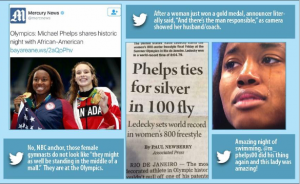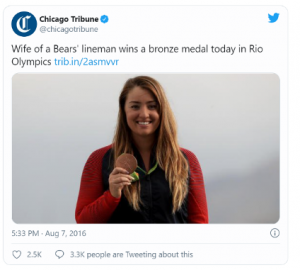13 The Greatest Tennis Player of All Time
Julia Ashton and Claudia Aparicio
Serena: She Knows It’s Not Right
We all know Serena Williams, the world-renowned female tennis player and titleholder of 23 grand slams, arguably The Greatest Tennis Player of All Time. Remember the 2018 US Open? During the final match against Naomi Osaka, Williams was penalized for coaching signals, breaking her racket, and calling the umpire a “thief’” (Press, 2018). She spoke out, exclaiming that her male counterparts had said and done far worse, yet she was being punished for questioning a bad call (Press, 2018). Since then, the media continues to portray her as hysterical, but when white male players do the same, they are simply seen as passionate (Press, 2018). The misrepresentation of female athletes extends past gender inequalities and is influenced by other disparities such as race, like in the case of Serena Williams. Misrepresentation of women in the media can manifest as other issues, when it truly originates from unequal representation. Take the case of the US national women’s soccer team winning the World Cup in 2015; the women’s team generated $20 million for US soccer. They won double the number of games, yet they earned a quarter of the men’s teams’ salary (Alvarez, 2019). Compared to the men’s team, the women generate less revenue from ticket and merchandise sales, but this is a direct consequence of the discrepancy in media coverage – if people don’t see it, they won’t support it. The pay gap is prevalent in countless sports, and it serves as a perfect example of media misrepresentation acting as the foundation upon which other issues of inequality arise. There are countless instances of the misrepresentation of women in sport, and they negatively impact girls’ confidence and participation, and they reinforce stereotypes about women.
‘Hotness’: The Perfect Resume Boost

Misrepresentation as defined by the Merriam-Webster dictionary, involves “…[intentional] or [negligent] false representations made verbally, by conduct, or sometimes by nondisclosure or concealment, and often for the purpose of deceiving, defrauding, or causing another to rely on it detrimentally” (Legal Definition of MISREPRESENTATION, n.d.). There are several ways women are misrepresented, from the sexualization of female sports broadcasters, to discrepancies in the amount and type of media coverage female athletes receive, as well as in the minimal opportunities for women to occupy leadership roles in sport. Consider this example: during an interview, Barstool Sports founder, David Portnoy, mentioned ESPN personality Sam Ponder, claiming that she was only hired because she is “hot” and that ‘hotness’ should be a top requirement for female sports broadcasters (Harrison, 2019). Unsettling, right? As more female broadcasters were interviewed, more examples were brought to light of network companies requiring their female employees to wear revealing clothing and look attractive, while male employees were never asked or expected to look a certain way (Harrison, 2019).
Lack of Female Leadership in Sport
Female coaches also face unequal circumstances, in part, as a result of inadequate representation on television. University of Victoria basketball coach, Dani Sinclair, explained that less than 24 hours after giving birth, she found herself urging her doctors to let her back on the court to coach a crucial play-off game (Szklarski, 2018). When asked why, she explained that she felt that as a female coach she had to prove herself by demonstrating that having a child was not a setback and or reason for her to leave her job. Sinclair discussed how being a female coach is tough given the lack of female representation in sports to aspire to. She recalled statistics about the steady decline of female coaches representing team Canada at the Olympics, as well as the general lack of female presence in sport leadership (Szklarski, 2018). The small number of female coaches employed in professional sports, paired with the lesser media coverage women receive from sport broadcasts and media outlets, perpetuates this issue of misrepresentation.
History of Inequality

We can attribute the ongoing misrepresentation of women in sport to the history of gender inequality and subjugation of women. Once the sex of a baby is determined, people traditionally associate boys with blue and girls with pink, or give boys a football but girls a doll (Wilde, 2007). Young boys are taught to be ‘masculine,’ while girls must be ‘lady-like’ and ‘feminine’ (Wilde, 2007). The idea that certain traits are ‘masculine’ initiated the masculinization of sport by pushing the idea that sports are ‘manly’. In some places in the early 1800s, women were finally allowed to attend male athletic events such as horse racing and baseball, but were expected only to participate in ‘feminine’ activities like dancing and ice skating (Wilde, 2007). Towards the end of the 1800s, women were finally allowed to play organized sports, however, physical contact was prohibited as it was deemed ‘unladylike’ (Wilde, 2007). This deep-rooted history of unequal gender stereotypes perpetuated the unequal presence and participation of women in sport, and has evolved into the misrepresentation of female athletes today.
Where’s the Screen Time?
The under representation of female athletes in the media has led to a lack of female athlete role models. Men grow up with countless role models to aspire after; think of any professional sports league and we guarantee you that every little boy who loves sport has at least one professional athlete he looks up to. Women do not have the same opportunities to look up to female athletes, because female sports are under represented in media. While women constitute 40% of all athletes participating in sport today, we only receive 4% of sports media coverage (MacKenzie, 2019). Herein lies part of the problem: the lack of female sports coverage eliminates opportunities for young girls to see themselves reflected on screen, and by extension, in society.
Breaking News: Serious Issues Affect Women Too
The media curates, influences, and perpetuates public opinion and societal ideals about content by controlling the framework of presentation. Because most media outlets are owned by corporations dominated by heterosexual, white men, minority stories are often told stereotypically, if told at all. A study by Glavinic (2010) indicates that out of 50 CBS news stories that involved professional insight, only 5 females were consulted as experts, and those stories were about babies, free meals from Denny’s, and a senior home’s bat mitzvah. (Glavinic, 2010). The male reporters told the other stories. Worse, in recent years, only 30% of CBS news stories focused on women as subjects. The lack of women in the news, both as experts and subjects, is not attributable to serious news not affecting women – we are as impacted by the closing of car companies, rising bank fees, and natural disasters, as men. What remains, rather, is a lack of women being included in serious news. This discrepancy perpetuates the stereotypes about the areas women are ‘supposed’ to excel in, because we only see what is fed to us onscreen, and like we said, media content is infested by gendered stereotypes. The ‘female’ content covered in the media restricts women to stereotypical roles deemed appropriate for girls, thereby enhancing the ideal of male superiority.
Witch, Blonde Bombshell, or Female Politician?
Women face resistance, discrimination, stereotyping, and double standards in the media, especially when they rise to positions of authority, like in politics. Female politicians are judged by how they look rather than by their opinions and ideals.

Belinda Stronach, who ran for leader of the Conservative Party in 2004, received media attention for her looks and alleged “lack of intellect”, and was described as a “puppet for the backroom boys”. Media attention on Kim Campbell, the first and only female Canadian Prime Minister, centered around her two divorces, the fact that she had no children, and her sexual allure as a “blonde bombshell” (Ross et al., 2017). Cathy Bennett, Newfoundland’s previous finance minister, referenced various instances on social media when she was described as a ‘monster’ and a ‘witch’, or when people wished her ill, like the individual who hoped she ‘chokes on her breakfast and dies’ (Ross et al., 2017). Hillary Clinton was subjected to jeers from men demanding she make them sandwiches. Rather than covering Michelle Obama’s professional endeavors, the media focused on her garden. This blatantly unequal quality of coverage of female politicians is enraging, because it reinforces gender stereotypes and beliefs about a woman’s ‘proper role’ in society.

Operating via gendered frameworks, the media belittles women’s political prowess for the same reasons that men are encouraged, making it difficult for female politicians to be considered as more than just a woman in politics. Just as some people deny Serena Williams the title of “Greatest Tennis Player of All Time,” people assume that female politicians cannot be good leaders in the same ways as white men are; female politicians are deemed quarrelsome for disagreeing with an opinion, selfish for working over raising a family, and unfeminine for pursuing a “male” career. While men can be aggressive, confident, and strong-willed, women are expected to be mild mannered and friendly. A woman is not strong-willed, she is bossy; she is not confident, she is full of herself; instead of aggressive, she is hot-headed and rude. It’s the exact same story in sport. Serena Williams is crazy and emotional for standing up for herself. Simone Biles is arrogant for correcting those who call her ‘The Next Michael Phelps’ in favor of ‘Simone Biles, gold medal Olympian’ (Garber, 2016). These gender stereotypes have existed for centuries, wedged within the foundations of the patriarchy upon which modern society was built.
The media objectifies women in politics and in sport by focusing on their appearance, family, and sexuality, rather than skill or experience. The unequal airtime female politicians receive in comparison to male politicians, mirrors that of female athletes. Female platforms, opinions, skill, and presence in the political and sport realms are diminished as a result of unequal representation.
Social Change
If they scrutinize a woman’s ‘hotness’, they could do the same for men, but treating men poorly is not the point. If a man is automatically referred to as a gold medal Olympian, so too, should Simone Biles be. Social change is as easy as focusing on female politicians’ opinions instead of what they’re wearing. It’s as easy as giving women the same amount of airtime on TV as men. It’s using the same terminology to describe a passionate outburst from Serena Williams or from a male athlete. The misrepresentation of women in the media is just one way that the issue of gender inequality manifests itself in society. We need to do better. It’s not fair and it’s not right. We know it’s not right; you know it’s not right, and Serena knows we all just can’t admit it.
References
Alvarez, A. (2019, May 9). I thought the main issue in women’s sports was equal pay. I was wrong. The Guardian. https://www.theguardian.com/sport/2019/may/09/i-thought-the-main-issue-in-womens-sports-was-equal-pay-i-was-wrong
Glavinic, T. (2010). Exclusion, Misrepresentation and Discrimination: Still Prevalent for Women in American Media and Politics. Inquiries Journal, 2(01). http://www.inquiriesjournal.com/articles/129/exclusion-misrepresentation-and-discrimination-still-prevalent-for-women-in-american-media-and-politics
Haraldsson, A., & Wängnerud, L. (2019). The effect of media sexism on women’s political ambition: Evidence from a worldwide study. Feminist Media Studies, 19(4), 525–541. https://doi.org/10.1080/14680777.2018.1468797
Harrison, G. (2019). “We want to see you sex it up and be slutty:” post-feminism and sports media’s appearance double standard. Critical Studies in Media Communication, 36(2), 140–155. https://doi.org/10.1080/15295036.2019.1566628
Johnson-Myers, T.-A. (2019). Negative Media Frames and Female Politicians: A Case Study of Jamaica’s First Female Prime Minister, Portia Simpson-Miller. Social Politics: International Studies in Gender, State & Society, jxz043. https://doi.org/10.1093/sp/jxz043
MacKenzie, M. (2019, July 16). Female Athletes Receive Only 4% of Sports Media Coverage—Adidas Wants to Change That. Glamour. https://www.glamour.com/story/female-athletes-receive-only-4-of-sports-media-coverage-adidas-wants-to-change-that
Press, A. (2018, September 9). Serena Williams accuses umpire of sexism and vows to “fight for women.” The Guardian. https://www.theguardian.com/sport/2018/sep/09/serena-williams-accuses-officials-of-sexism-and-vows-to-fight-for-women
Ross, A., December 24, 2017 2:51 PM MT | Last Updated:, & 2017. (2017, December 17). Sexist media scrutiny of women in politics spans decades, study says | CBC News. CBC. https://www.cbc.ca/news/canada/edmonton/media-representation-women-politics-1.4453407
Szklarski, C. (2018, February 2). Women coaches in Canadian sport far and few between. Thestar.Com. https://www.thestar.com/news/canada/2018/02/02/women-coaches-in-canadian-sport-far-and-few-between.html
Wilde, K. (2007). Women in Sport: Gender Stereotypes in the Past and Present. /paper/Women-in-Sport-%3A-Gender-Stereotypes-in-the-Past-and-Wilde/5a2a570f2d4ebbbbf924c5ed2b6f81076b3f5260

